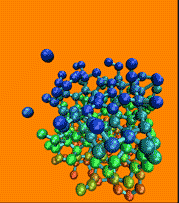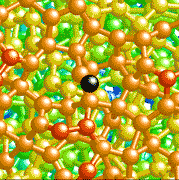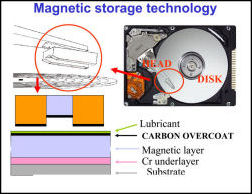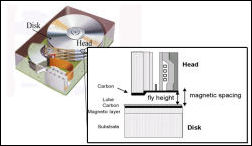Ultra-smooth diamond-like carbon surfaces are key to enable the ultimate storage density of 1 terabit/ inch2 in next generation ultra-high storage density hard disks.



Researchers here in the Department shed light on how these surfaces grow, the key to enabling design engineers and manufacturers to optimize the structure of these surfaces for this and other applications.
Coatings need to be smooth in order to reduce friction and prevent wear. Cinzia Casiraghi, Dr Andrea Ferrari, and Professor John Robertson from the Department have co-authored a paper with colleagues at the Fraunhofer Institute for Mechanics of Materials IWM in Freiburg and the University of Karlsruhe, published in the journal Science (Vol. 309, Nr. 5740, September 2, 2005 abstract, full text, pdf version ), explaining how diamond-like carbon films grow and why they are almost atomically smooth. The ultimate purpose is to tailor the surface characteristics of coatings to any tribology application. In particular, ultra-smooth diamond-like carbon surfaces are key to enable the ultimate storage density of 1 terabit/ inch2 in next generation ultra-high storage density hard disks.
Without them, PC hard disks would simply not work, bearings would wear out faster, and seals would soon start to leak. Diamond-like carbon films have a low coefficient of friction and a high resistance to wear: the ideal properties for interacting moving parts, such as those found in machine tools, racing car engines or microelectronic devices. Produced from ordinary carbon, it is the arrangement of atoms in the layer of film that determines its properties. Until now, the design of films with specific properties was based on empirical knowledge and a great deal of experimentation.
The importance of smoothness in diamond-like carbon films can be illustrated by the example of a computer hard disk. The read head spins over the surface of the magnetic disk at a height of a few nanometers. All that separates them is a thin film of lubricant and the protective carbon coating on the surface of the disk. Any roughness in this carbon film would impair the quality of the storage medium. As storage density increases, the distance between the read head and the data medium has to be reduced still further. To achieve the ultimate storage density of 1 terabit/ inch2 in next generation ultra-high storage density hard disks, every single layer of atoms counts.
In order to optimize the structure of films for this and other applications, and be able to deliberately manipulate their characteristics, design engineers and manufacturers want to understand how the atoms are laid down on the surface of these films and how the layer grows.
The molecular-dynamic simulations and experiments undertaken by the teams of University of Cambridge and the Fraunhofer Institute for Mechanics of Materials IWM in Freiburg explain the ultra-smoothness of diamond-like carbons. In Volume 309, Nr. 5740 of the journal Science, published on September 2, 2005, the researchers present their new concept explaining the formation of almost atomically smooth diamond-like carbon films.
According to their model, the atoms pile up during the deposition process in an array of tiny heaps, rather like grains of sand being poured onto a flat surface. The next carbon atoms to land on the sides of these uneven structures pull other atoms with them as they slide downward, like someone walking on a loose gravel slope. The result is a kind of erosion on an atomic scale, leading to the much-cited extraordinary smoothness.
The mathematical formulae describing the formation and growth of diamond-like carbon films now open the way to the virtual design of surface structures with tailor-made characteristics.
For more information contact:
Dr Andrea Ferrari



